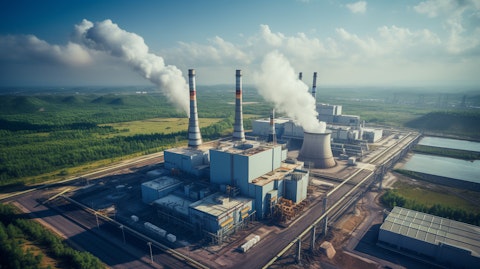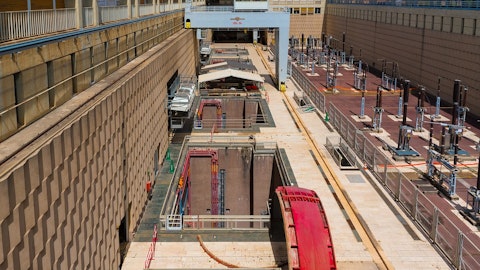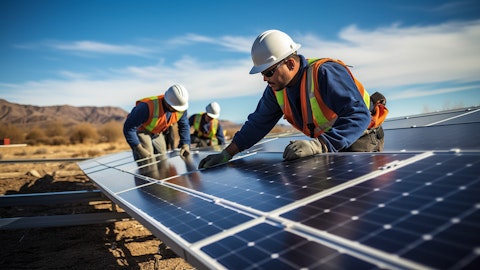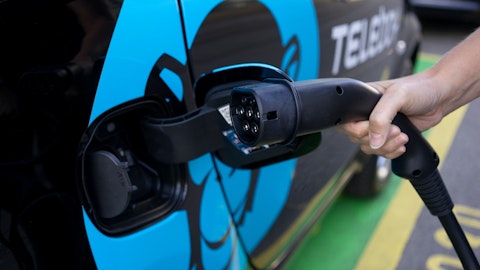Bloom Energy Corporation (NYSE:BE) Q3 2023 Earnings Call Transcript November 8, 2023
Bloom Energy Corporation beats earnings expectations. Reported EPS is $0.15, expectations were $-0.03.
Operator: Good evening, ladies and gentlemen. Thank you for attending Bloom Energy’s Q3 2023 Earnings Conference Call. My name is Adam, and I’ll be the moderator for today’s call. [Operator Instructions] I will now pass the conference over to your host, Ed Vallejo, Vice President of Investor Relations. Please proceed.
Ed Vallejo: Thank you, and good afternoon, everybody. Thank you for joining us for Bloom Energy’s third quarter 2023 earnings conference call. To supplement this conference call, we furnished our third quarter 2023 earnings press release with the SEC on Form 8-K and have posted it along with supplemental financial information that we will reference throughout this call to our Investor Relations website. During this conference call, both in our prepared remarks and in answers to your questions, we may make forward-looking statements that represent our expectations regarding future events and our future financial performance. These include statements about the company’s business results, products, new markets, strategy, financial position, liquidity and full year outlook for 2023.
These statements are predictions based upon our expectations, estimates and assumptions. However, as these statements deal with future events, they are subject to numerous known and unknown risks and uncertainties as discussed in detail in our documents filed with the SEC including our most recently filed Forms 10-K and 10-Q. We assume no obligation to revise any forward-looking statements made on today’s call. During this call and in our third quarter 2023 earnings press release, we refer to GAAP and non-GAAP financial measures. The non-GAAP financial measures are not prepared in accordance with U.S. Generally Accepted Accounting Principles and are in addition to, and not a substitute for, or superior to measures of financial performance prepared in accordance with GAAP.
A reconciliation between the GAAP and non-GAAP financial measures is included in our third quarter 2023 earnings press release available on our Investor Relations website. Joining me on the call today are KR Sridhar, Founder, Chairman and Chief Executive Officer; and Greg Cameron, our President and Chief Financial Officer. KR will begin with an overview of our business, then Greg will review the operating and financial highlights of the quarter as well as the outlook for the year. After our prepared remarks, we will have time to take your questions. I will now turn the call over to KR.
KR Sridhar: Hello, everyone and thanks for joining us today. We are continuing to execute on growing our business in the US and around the world. We remain heads down and focused on performing and innovating at a high level. We continue to increase revenue and expand our growth and operating margins. We do this by selling value to our customers, maintaining price discipline, and reducing costs. In fact, we have lowered costs six quarters in a row, just as we said we would do. We are achieving new levels of success. The strong numbers we report today is a proof point that our business model is working and can be profitable. We are well capitalized to continue innovating and handle the cyclical and lumpy nature of our business.
The rise in power demand continues to be both steep and sustained. Record high temperatures, adoption of EVs, electrification, data center growth, AI and reassuring of industries have all been strong drivers of electricity demand. The antiquated and sluggish electric grid is unable to keep up with this rapid demand spike. A case in point 66 gigawatts of greenfield projects are delayed in the US and only 14% of capacity requesting interconnection from years 2000 to 2017 reached commercial operations by the end of 2022 according to a Department of Energy Lab report. Bloom Energy’s products and architecture are uniquely suited to these times for both behind and in front of the meter. Where necessary, we can operate in an islanded mode without grid interconnection and offer our customers quick, reliable, and clean power.
As an example, we installed 7.8 megawatts of Bloom servers at Coherent, Pennsylvania factory, allowing for significant electrical load to be supplied to that site independently from the grid. The Bloom servers provide clean and reliable power that fortifies the factory’s critical infrastructure and helps Coherent meet both customer demand and revenue growth. While the issue of rising interest rates and global conflicts creates some headwinds, there is no question that demand for clean power and the need for availability and reliability will create definite and sustained tailwinds for our business. Looking at our sales inquiry pipeline, the impact of AI to our business cannot be overstated. AI clearly has the potential of expanding the adoption of our products in the data center market.
AI powered search on a GPU will take five to 20 times more power per search compared to a regular search on a CPU and the use of AI is growing rapidly across all segments of our society. This will exponentially increase energy demand in data centers over the next decade. If we look at the projections of future growth from the chip companies and cloud service providers, the imbalance in grid availability and the accelerating demand for compute power is expanding the case for Bloom in this sector from resilience to one of timely primary power availability. For example, we powered our first customer in Taiwan and signed our first customer in Singapore recently. In Taiwan, we installed the first phase of a 10 megawatt solid oxide fuel cell contract with Unimicron Technology Corporation, a chip substrate and printed circuit board maker.
Our energy servers went from contract to power on in less than six months, which shows how quickly we can move to solve power availability problems. That success helped us land our first deal in Singapore. Working with our partner SK ecoplant, we will deploy our Bloom Energy Servers with GDS, a leading developer of high performance data centers. This is exciting as it is illustrative of the strength of our servers as a solution for data centers. In addition, Singapore is a market where 90%-plus of power is natural gas-based today. While we will start with natural gas, our systems are future proofed. Our customers can switch to carbon capture, to hydrogen or to green ammonia once the regional infrastructure, supply chain and regulatory frameworks are established for those cleaner options.
We think this is a model for future projects and it demonstrates the competitive advantage of our fuel flexible platform. Let me spend just a moment on hydrogen. We have long been focused on hydrogen and its many benefits, particularly given the flexibility of our platform technology to operate as fuel cells to provide power or as electrolyzers to produce hydrogen. As many of you know, the Department of Energy announced just a few weeks ago, a $7 billion nationwide investment designed to launch seven regional clean hydrogen hubs across the country. Bloom Energy electrolyzers, that included in four of the seven winning hydrogen hubs. This should come as no surprise. Bloom Energy is unique in the electrolyzer industry in being able to offer both the highest electrical efficiency products and deliver them at scale today from our fully operational giga factories in Fremont, California and Newark, Delaware.

It is early days for what will be a huge market, but we are clearly pleased about our wins and what it means for Bloom and the world in the future. So to close, growing demand for power solutions driven by data centers and AI is relentless focus on cost discipline and efficiency, a deep commitment to innovation and fuel flexibility, all make us excited about Bloom Energy’s future. I’ll be back with you to answer questions. For now, let me hand it over to Greg Cameron. Greg?
Greg Cameron: Thanks KR. Let me begin with a few highlights about our strong execution in the third quarter. We had a record third quarter revenue of $400 million, up 37% versus last year. Our margins improved. Third quarter non-GAAP gross margins were roughly 32%, bringing our year-to-date margins to 25%, up 680 basis points versus prior year. We continue to execute on cost reductions. Product costs are down 18% versus last year, and our operating expenses are down approximately 20% from the first quarter. Our service margins improve versus the prior quarter, and we expect this quarterly trend in service to continue. We ended the quarter with a total cash balance of roughly $638 million. We are reaffirming our 2023 framework for revenues, margins, and profitability.
With those as highlights, let me provide some additional context to our performance. As the need for additional electricity grows, our customers recognize the value of affordable, reliable, and flexible power solutions. Our ability to bring fuel flexible power onsite quickly with our energy server, coupled with combined heat and power and carbon capture solutions, provides a competitive advantage versus alternatives. We remain focused on both large scale projects such as data centers, where the energy project dynamics are complex, requiring longer sales cycles, as well as shorter term projects where the customer needs solutions until the power is available from a local utility. As you heard from KR, our electrolyzer has been selected for several hydrogen hubs.
These project sponsors like many large scale project developers, clearly value our efficiency advantage in manufacturing readiness. As these projects move through their investment decisions, we expect to make announcements on our technology deployments. Historically, most of our bookings close in the fourth quarter. This year is no different as we are very focused on converting our commercial pipeline to orders over the next couple months. Each opportunity has its own unique challenges such as permitting, interconnection timing, complexity, IRA incentives, et cetera. Although these challenges have added to our sales cycle times, our sales team is committed to delivering a robust backlog to grow our future revenues. We look forward to sharing our results in our year-end earnings call in February.
This past quarter, SK ecoplant converted 13.5 million redeemable convertible preferred shares to common equity. We are grateful for their trust and are excited to continue our partnership. As part of this conversion, we eliminated 311 million in liabilities and recorded a non-cash interest charge of $53 million. When SK ecoplant made their investment in the first quarter, they had the option to convert the RCPS to either debt or equity by the end of the third quarter. As they have elected equity, we are expensing the loan commitment asset established in the first quarter to interest expense. This expense is being removed as a pro forma adjustment to our non-GAAP reporting. Our third quarter non-GAAP gross margins of 32% improved 12.4 points versus the third quarter 2022.
The margin increase was driven by maintaining pricing on acceptances while reducing unit costs. Both price and costs were positively impacted by the repowering of PPA V. The PPA V repowering is similar to the 2022 PPA repowering. We executed the sale of a previously consolidated PPA entity and by doing so, we paid off $119 million of non-recourse debt, enhanced current margins, and simplified our financial reporting. As part of this transaction, we recorded $133 million of charges through our Electricity segment, operating expenses and other expense that were removed as a pro forma adjustment from our non-GAAP reporting. This was our last remaining consolidated PPA entity. I want to spend a minute on the impact from rising interest rates on securing project financing.
As rates have increased over the past two years, investor cost to capital expectations have also increased. Over this period, we have obtained project financing at attractive rates, allowing us to maintain our product margins. Early in the cycle, we offset much of the pressure through an improving Bloom Energy credit profile. Over the last 12 months, as benchmark rates have continued to rise, we’ve been able to offset additional pressure through ITC benefits for energy communities and domestic content. Going forward, we will endeavor to offset additional pressure through reducing product cost, maintaining pricing discipline as the cost of alternatives continues to increase competitively bidding new financings and a possible extension of ITC benefits post 2024.
Our product margin benefited from nearly 18% reduction in product costs year-over-year. Lower material costs coupled with automation and increased power output are driving down product costs. Every quarter this year we’ve achieved double-digit cost reductions and we are confident we will achieve our 2023 target of 12% product cost down as we position ourselves for a strong 2024. In the fourth quarter, we are consolidating our California stack manufacturing into our state-of-the-art Fremont facility. Consolidating our legacy Sunnyvale activities in Fremont will reduce headcount and expenses as we maintain our capacity. As expected, our third quarter results and service improved versus the second quarter, and we expect them to continue to improve as revenues grow, performance payments reduce and replacement power module costs reduce.
We remain committed to our service business achieving a 20% non-GAAP gross margin by 2025. In the third and fourth quarter, we have executed a few targeted restructurings to reduce costs. We are committed to delivering profitable growth as we continue to invest in our future. We targeted areas that can be reduced without impacting our technical competencies, our commercial capabilities. These actions have resulted in reducing our operating headcount about 10%, a restructuring charge of roughly $2 million was recorded in the third quarter with an additional $6 million to be recorded in the fourth quarter. Both will be pro forma adjustments to our non-GAAP reporting. We are reaffirming our 2023 annual guidance for revenue, margins and profitability.
Based on anticipated fourth quarter acceptances, we expect to deliver $1.4 billion to $1.5 billion of annual revenue at our targeted 25% non-GAAP gross margin. At this revenue and gross margin profile, we should achieve a positive non-GAAP operating margin for the year. As we’ve previously discussed, Bloom is committed to becoming profitable this year, and we are well-positioned given our performance year-to-date. I no longer expect to be CFOA positive for the full year. We are holding additional inventories to support our previously announced time to power value proposition that’s elevated our working capital levels. We will continue to be diligent with our investments in working capital, ensuring that we are balancing growth, profitability, and liquidity.
In summary, we had a strong operational quarter. As we move forward, we were operating with discipline and focus, and we have compelling product solutions for a net zero carbon future. We’re excited about our future. With that, operator, please open the line for questions.
See also 20 Cheapest Beach Towns to Live in the World and 25 Best Places to Retire in the UK.
Q&A Session
Follow Bloom Energy Corp (NYSE:BE)
Follow Bloom Energy Corp (NYSE:BE)
Operator: [Operator Instructions] Your first question comes from the line of Andrew Percoco with Morgan Stanley. Your line is open.
Andrew Percoco: Great. Thanks so much. Good evening, everyone. I just want to start with South Korea. I think they recently switched to an auction process for fuel cell purchases over the last few months. Can you maybe just discuss how this is impacting timing of deliveries to SK and if they are delayed, do you have the ability to backfill those orders with other projects outside of South Korea? Thank you.
Greg Cameron: Andrew, it’s Greg. Thanks for the question. Listen with SK, huge partner for us and we’re very appreciative that they showed more confidence in us and as they executed on the conversion equity this quarter. I’ve spent a lot of time in Korea over the course of this year and really excited about the market opportunity. To your point, the CHPS standards, the Clean Hydrogen Portfolio Standards have come in this year and there’s been two bidding processes. There was one in the summer, and then there’s one currently going on right now. It looks to be as though as we’ve lined up with our partner, we’re really excited about the opportunities that we’ve seen and we’re going through that process now with bidding — with conclusion on the bidding.
And we’ll know more in the next few weeks there. But I will tell you really tight alignment between the two teams and understanding how to add value and continue to win in that market. So we’re really encouraged about the near-term in that space and as well as the long-term in Korea.
Operator: Your next question comes from the line of Julien Dumoulin-Smith at Bank of America. Your line is open.
Julien Dumoulin-Smith: Hey, good afternoon team. Thank you guys very much. Just first off, can you elaborate a little bit more on the inventory? I mean, what’s going on in terms of CFOA and just to what end the buildup and working capital there? I mean, what is that saying about 2024 really is I think what is an interesting nugget or clue there? And then related, can you just elaborate a little bit on where you stand on some of these data center deals like Amazon, what’s included this year or next year and what are you seeing just on the data center activity front, whether that’s with Amazon or in Ireland or frankly, some of these other opportunities. How much of the overall build could you be seeing in 2024 derive from those as you think about your backlog or guidance composition?
Greg Cameron: Yeah. Thanks Julien. I’ll start and — it’s Greg and then I’ll pass it over to KR specifically on the data centers. Look on the working capital, you see the inventory increase so far this year. We are up, we’ll call it $250 million. As we’ve built inventories, we prepared to really reduce the cycle time for our customers on a need for power. So that’s what’s negatively impacting our CFOA. I pointed to EBITDA, just the EBITDA positive so far this year, so it wasn’t a cash burn that’s coming through operations. It’s more of an investment that we’ve purposely made in order to make sure that we can continue to respond quickly. And a lot of that is given our confidence in what we’re seeing in the commercial pipeline and knowing that our customers have a time to power issue, and yet we still need to get per through permitting and everything else.
But once that’s cleared, they very quickly want that power, and they do not want to wait for long lead items to come in. So we’ve purposely built up some of that inventory based on our confidence in our pipeline, and that converting into orders that we’ll need to convert to deliveries very quickly. And that’s the reason that those inventories are up. And then we were very prudent around our working capital, but as I looked through it for the rest of the year, KR and I sat back and said, to make the CFOA target, there is no reason for us to drive our inventory levels down below a level that’s going to put us in a spot where we’re not going to be able to meet need next year. So we purposely kept those up and thought it was prudent for the company as a way to help respond to the customers.
I’ll let KR talk about data centers.
KR Sridhar: Hey, Julien. So look, data centers was red hot prior to ChatGPT. I don’t even know how to describe the color of where those data centers are going post ChatGPT, right? The AI searches on average will be significantly greater in the power hungry need of those chips, the GPU chips compared to the CPU chips. So whether it’s an existing data center that’s converting from CPU to GPU or a new data center that’s needed because almost all of society is beginning to use AI right now, what part of the society do we know that, that is not going to embrace it? The shortage of power that existed prior to GPT is only getting significantly greater. So whether it’s Virginia or the San Jose, Santa Clara area, between those two centers, roughly 70%, 80% of the data centers in the country exist in these two places.
They both have severe shortage of power for what the needs are. That story — I was in Taiwan, I was in Singapore. Whether it’s the chip makers and whether it’s the ecosystem and the semiconductor industry supplying these parts, or whether it’s the data centers themselves in Singapore, you are seeing exactly the same story. That story plays over again in Ireland. So we think that this is a real opportunity that’s going to be sustained for a long period of time. And Bloom with its modular, reliable infrastructure, ability to switch to a cleaner fuel as they come along, the pay as you grow modular nature of what we do, our established presence in the data center industry already as a reliable provider of power. You put all that together, we think it’s a phenomenal opportunity for us going forward.
These are complex, big deals. They take time to come together, but we — it is our single largest inquiry. Thank you.
Operator: Your next question comes from the line of Chris Dendrinos with RBC Capital Markets. Your line is open.
Chris Dendrinos: Yeah. Thank you. I wanted to shift the conversation a little bit to the hydrogen topic here. The Project Nujio’qonik, it looked like the EIS was submitted a couple months back and then still waiting for a response there. Is there anything more to say on that program right now? And when we could maybe hear an announcement on the award, I guess, of the demand to Bloom? I will leave it there. Thanks.
KR Sridhar: So to the extent that our customer speaks about it or our partners speak about it, we let them do that. But until a deal is finalized, it’s normally not our habit to talk about it. So I’m not going to put — give you any more color other than we are very engaged in that project. I can confirm that. And then, in terms of the hydrogen larger story, I think the big news really is the $7 billion hydrogen hubs and how we have been selected in four of the hubs. And we have invested, and we are continuing to invest in a big way in hydrogen because we believe we have the world’s most efficient electrolyzer that can be deployed at scale. And we see this as a huge opportunity.
Operator: Your next question comes from the line of Ben Kallo with Baird. Your line is open.
Ben Kallo: Hey, thanks guys and good evening. Just on the movement over to Fremont. How do we think about any impacts into Q4? I think it’s probably seamless, but just wanted to get your thoughts on that. And then just on repowering, is there any way you can quantify the impact on margin there? Thank you.




